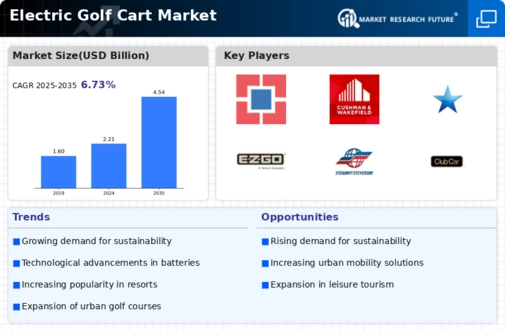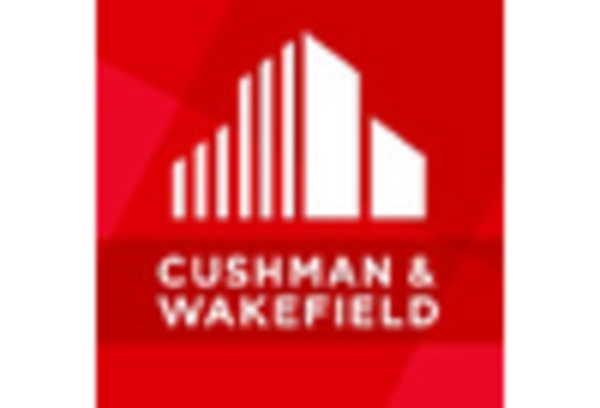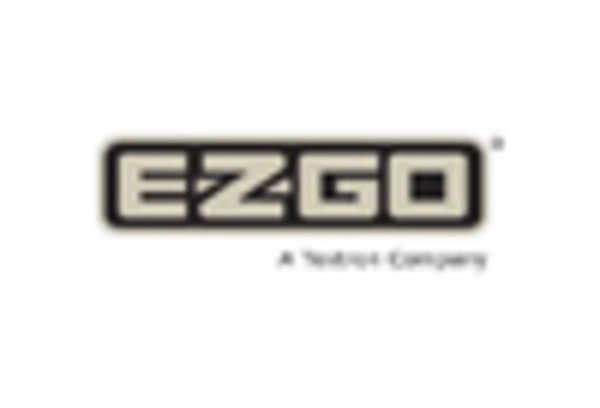Regulatory Support
Regulatory support is emerging as a crucial driver for the Electric Golf Cart Market. Governments worldwide are implementing policies and incentives to promote electric vehicles, including golf carts. These regulations often include tax breaks, subsidies, and grants aimed at encouraging the adoption of electric transportation. For instance, certain regions have established low-emission zones where electric golf carts are favored over traditional gas-powered models. This regulatory environment not only fosters consumer interest but also incentivizes manufacturers to innovate and expand their electric offerings. As a result, the Electric Golf Cart Market is likely to benefit from a favorable policy landscape that encourages sustainable transportation solutions.
Sustainability Initiatives
The Electric Golf Cart Market is experiencing a notable shift towards sustainability initiatives. As environmental concerns gain traction, consumers and manufacturers alike are prioritizing eco-friendly transportation options. Electric golf carts, which produce zero emissions, align with the growing demand for sustainable practices in recreational activities. According to recent data, the market for electric golf carts is projected to grow at a compound annual growth rate of approximately 6.5% over the next five years. This growth is driven by the increasing adoption of electric vehicles and the push for greener alternatives in leisure activities. Furthermore, golf courses are increasingly investing in electric carts to enhance their sustainability profiles, thereby contributing to the overall expansion of the Electric Golf Cart Market.
Technological Advancements
Technological advancements play a pivotal role in shaping the Electric Golf Cart Market. Innovations in battery technology, such as lithium-ion batteries, have significantly improved the performance and efficiency of electric golf carts. These advancements not only extend the range of electric carts but also reduce charging times, making them more appealing to consumers. Additionally, the integration of smart technologies, including GPS and telematics, enhances user experience and operational efficiency. The market is witnessing a surge in demand for high-tech features, which is likely to drive growth. As manufacturers continue to invest in research and development, the Electric Golf Cart Market is expected to evolve, offering more sophisticated and user-friendly products.
Changing Consumer Preferences
Changing consumer preferences are significantly influencing the Electric Golf Cart Market. As more individuals seek convenient and environmentally friendly transportation options, electric golf carts are becoming increasingly popular among various demographics. This shift is particularly evident among younger consumers who prioritize sustainability and technological integration in their purchasing decisions. Additionally, the rise of urban golf courses and recreational areas has created a demand for electric carts that are easy to maneuver and operate. Market data indicates that the demand for electric golf carts is expected to rise, with a notable increase in sales projected over the next few years. This trend reflects a broader societal shift towards eco-consciousness and convenience.
Expansion of Golf Courses and Resorts
The expansion of golf courses and resorts is a significant driver for the Electric Golf Cart Market. As new golf facilities emerge and existing ones undergo renovations, the demand for electric golf carts is likely to increase. Many golf courses are recognizing the benefits of electric carts, including lower operating costs and enhanced customer experience. Furthermore, resorts are incorporating electric golf carts into their amenities, providing guests with eco-friendly transportation options. This trend is supported by Market Research Future indicating that the number of golf courses is projected to grow steadily, thereby creating a larger customer base for electric golf carts. Consequently, the Electric Golf Cart Market stands to gain from this expansion, as more facilities adopt electric solutions.


















Leave a Comment